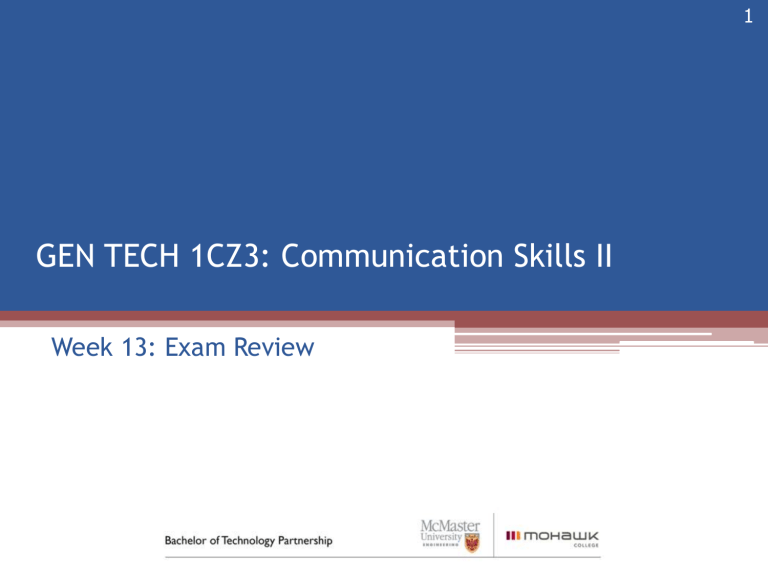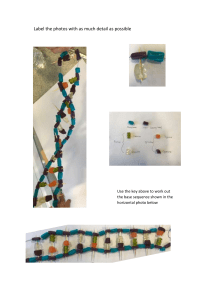
1 GEN TECH 1CZ3: Communication Skills II Week 13: Exam Review 2 Learning Objectives • Identify what you remember from the term • Present an overview of topics that will likely be touched upon in the final exam • Review material covered throughout the term • Note: all textbook material covered and all slideshow material is fair game! 3 EXAM FORMAT • Part A: 40 MC • Part B: Choose 3 of 4 written • Be sure to put instructor name on booklet! • Your name & ID # on all materials as prompted 4 5 6 Wk 2: Ethics Chapter 6 7 Wk 2: What is ethical communication? • • • • Emphasizing certain information over others Half-truths Suppressing bad news “Alternative” facts • Contradictory goals within a company: ▫ Production ▫ Safety 8 Wk 2: Perils of ‘group think’ Team work Group think 9 Wk 2: Obligations Help Determine What is Ethical Ourselves Clients Company Co-workers Community Society 10 Wk 2: Political Compass • https://www.politicalcompass.org/test 11 Wk 3: Research & Data Appropriate Sources Chapters 7 & 8 Primary Secondary 12 Wk 3: Primary Sources Informative interviews Surveys Questionnaires Inquiries (to experts) Socialnetworking posts Observation and experiment Analysis of samples (field) Public and company records and literature 13 Wk 3: Evaluating Findings (Ch. 8) 14 Wk 3: Assessing the Entire Research Process We need to examine our own methods of research as much as we do the writers/researchers of the material we have researched. • See checklist for evaluating the overall research process (p. 149) ▫ Reasoning vs. Methods 15 Overview of Procedural Stages of the Research Process (p.106) Searching for information Recording your findings Assessing and working with the findings Documenting your sources Writing the report 16 Wk 4: Information Analysis & Manipulation Chapters 8 & 9 17 Wk 4: Paraphrasing vs. Direct Quotes (Ch.9) Paraphrasing: Putting someone else’s facts, words, or ideas into your own words. Citing: use the source’s number (IEEE) or the author’s name and year (APA) Quoting: Putting someone else’s facts, words, or ideas into your work without any changes. Citing: use the source’s number with the specific page number (IEEE) or, the author’s name, year and page number (APA) 18 9 elements of critical thinking 19 Wk 5: Audience and Persuasion Chapter 5 20 Wk 5: Reactions to Persuasion (p.73) Internalization • The ideal response Identification • A willing and productive response Compliance • A grudging and often unproductive response 21 22 Wk 6: Formal Analytical Reports Chapter 19 23 Wk 6: The difference between formal and short reports 1. Described as lengthy analytical reports “when the topic is important enough to warrant formal presentation” Analytical Reports answer these questions: 1. What do we know? 2. What does it mean? 3. What is the bottom-line conclusion we can draw? 4. What should we do? 24 Wk 6: Four Types of Formal Reports Evaluation Recommendation Feasibility Causal 25 Wk 6: Elements of Formal Reports Section of Purposes of the Section the Report Front matter • To orient the reader to the subject • To provide summaries for technical and managerial readers • To help readers navigate the report and decide whether to read the document Body • To provide a comprehensive account of the project (problem, methods, findings) Back matter • To present supplementary information and enable readers to consult secondary sources 26 Wk 7/8: Descriptive Writing: Definitions Chapter 14 27 Wk 7: Types of Definitions Parenthetical Clarifying Sentence Expanded 28 Wk 7: Term = class + distinction Standard structure of sentence definitions 1. Term being defined 2. The class (group term) in which it belongs 3. Distinctions of how that term is different from other members of its class e.g. The ScanPen 150 is hand-held, batteryoperated scanning device about the size of a pen, capable of scanning bar or QR codes, as well as text. 29 Wk 7: Expansion Methods 30 Wk 7: Expansion Methods Types Explanation Etymology Origins of the term History and background How something came into existence Negation What it is not Operating Principle What makes something work? Analysis of Parts What makes up this term? 31 Wk 7: Expansion Methods Types Explanation Comparison and contrast Required Materials or Conditions Example As it relates to something else Appearance What does it look like? (Ewald, 2014) Function/purpose (Ewald, 2014) Requirements or restrictions Familiar examples showing types or uses Its reason for being/its purpose 32 Wk 7: Summarizing information (Ch.10) 33 Wk 8: Descriptions, Specifications Chapters 15 34 Wk 8: What is a Description? • Descriptions – create pictures with words • Technical descriptions – convey information about a product or mechanism so that someone can use, buy, operate, assemble, or manufacture it 35 Spatial sequence • What is it? What does it do? What does it look like? Functional sequence • How does it work? Chronological sequence • How has it been put together? Combined sequence 36 Wk 8: Specifications Describe standards for performance, safety, and quality for almost any product Specifications give: • Methods for manufacturing, building, or installing the product • The materials and equipment to be used • The size, shape, and weight of the product 37 38 Wk 8: Elements of a Mechanism Description (pg.256) Clear & Limiting Title Overall Appearance and Component Parts Visuals Function of Each Part Appropriate Level of Detail Clear Descriptive Sequence 39 Wk 9: TYPES OF VISUALS TO CONSIDER Chapter 12 Tables display organized lists of data Graphs display numerical relationships Charts depict relations Graphics rely on pictures 40 Preferred Visuals for Specific Purposes Organize numerical data Table Show comparative data Table, bar graph, line graph Show a trend Line graph Interpret or emphasize data Bar graph, line graph, pie chart, map Introduce an unfamiliar object Photo, representational diagram Display a project schedule Gantt chart Show how parts are assembled Photo, exploded diagram Show how something is organized Organization chart, map Give instructions Prose table, photo, diagram, flow chart Explain a process Flow chart, block diagram Clarify a concept of principle Block or schematic diagram, tree chart Describe a mechanism Photo, representational diagram, or cutaway diagram 41 Thank you for your attention Questions? GOOD LUCK!



